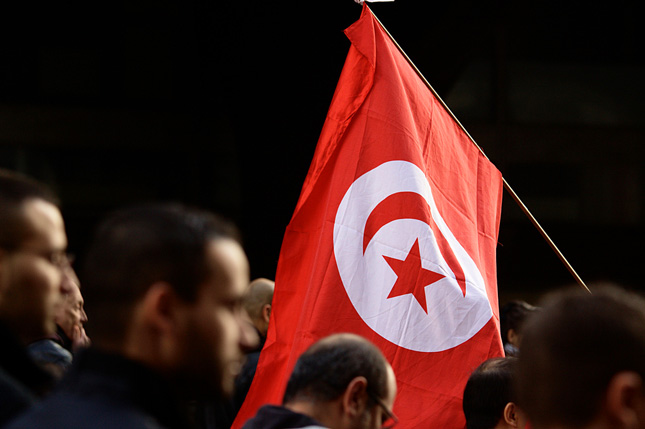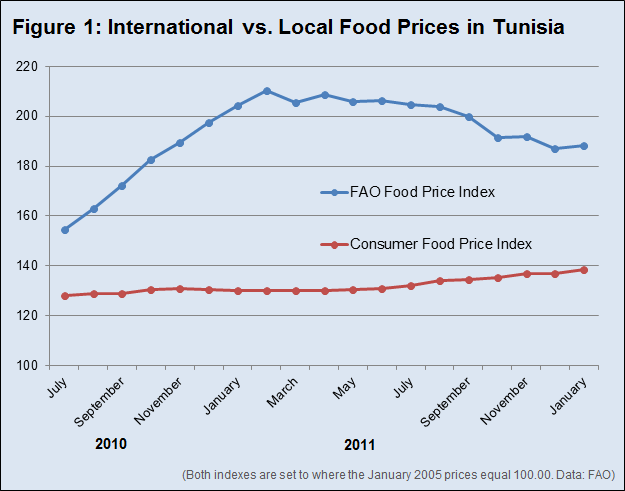-
High Food Prices an Unlikely Cause for the Start of the Arab Spring
April 7, 2014 By Richard Cincotta
Just months after popular uprisings toppled Tunisia and Egypt’s authoritarian regimes, a trio of complex-system researchers published a brief article linking these demonstrations with high levels of the UN Food and Agriculture Organization’s international Food Price Index. Marco Lagi, Karla Bertrand, and Yaneer Bar-Yam’s model, which predicts outbreaks of deadly social conflict when the index tops 210, has since become a popular explanation wielded by many for bouts of popular unrest, including the Arab Spring and overthrow of Ukraine’s government. But were food prices really an underlying “hidden” cause for the start of a wave of instability that is still being felt today?
Not everyone is convinced, least of all, international food policy analysts.
Local Context Matters
An important factor to consider is the difference between the aggregate, international prices tracked by the FAO Food Price Index and the prices paid on the street for the same “basket” of commodities.
Several analysts have shown that in Tunisia – the political epicenter of the Arab Spring, the most successful pro-democracy movement (so far), the enabler of other anti-regime movements that soon followed, and a heavily import-dependent consumer of grain – government food-price controls held fast. Both before and during the demonstrations that ultimately toppled President Zine El Abidine Ben Ali, Tunisia’s consumer food price index showed few signs of being influenced by the rapid rise of the FAO index.

The first evidence suggesting Tunisia’s pro-democracy demonstrations erupted independently from the surge in international food prices actually preceded the article by Lagi and his colleagues. On January 31, 2011, GIEWS – the FAO’s on-the-ground early warning system – released a bulletin reporting “relatively stable domestic prices despite high international food prices” in Tunisia’s consumer food markets during the winter months of 2010 to 2011. The bulletin also explained that “the hike in international food prices has not translated into high domestic prices.” In fact, Tunisia’s consumer food price index declined slightly between November and December 2010.
The government’s food price management efforts buffered prices through 2010 and into July 2011An April 2012 review of Tunisia’s pre- and post-revolution inflation trends by the African Development Bank’s Chief Economist Complex makes it similarly clear that the government’s food price management efforts, which included tightly regulated prices on about 30 percent of common food items and a compensation fund for subsidizing poor consumers and farmers, buffered prices through 2010 and into July 2011. The authors note that the local index rose slowly only after the transition government relaxed some controls in mid-2011 in order to relieve fiscal pressure on the compensation fund and slow the accumulation of debt.
Further, a World Bank report from March of 2012 compared consumer food prices among the countries of the region and found that Tunisia was among the most insulated from changes in international prices. Because food price controls insert a time lag between international food prices and the response in local consumer markets, food policy analysts use a lag indicator called the “pass-through coefficient” (PTC). The PTC estimates the proportion of change in the FAO Food Price Index that is transmitted to the consumer food price index over a specified time (usually six months or a year). The lower the coefficient, the more protected local food markets are from international price spikes.
According to this report, Tunisia and Algeria maintained the lowest food price PTC during the 2010 to 2011 period. Six months after a one-unit rise in the FAO Food Price Index, Tunisian and Algerian consumers could expect to experience an average food price increase of only about 0.05 units. In contrast, Egyptian consumers were much less sheltered – that country’s PTC for the same six-month period was higher, allowing a rise of 0.33 units for every unit of change – and the coefficients were even larger in the local markets of some Gulf States.
Controlling Prices
Controlling food prices may sound like a simple matter, but it’s not. Farm subsidies, underwriting food imports, and the operation of government storage and disbursement facilities are financially costly, and they undercut market efficiencies and production incentives. Moreover, it takes considerable institutional capacity to effectively police markets, and firmly and fairly regulate merchants without facilitating corruption, encouraging black marketeering, or forcing food suppliers out of business.
The rapidly growing urban populations of low-income, import-dependent countries are the most vulnerableTheoretically, those states with substantial institutional capacity, adequate foreign currency reserves, and a significantly productive agricultural sector should be the most likely to buffer international price shocks. Empirically, that is indeed the case – with the exception of a few cases where grain exporters poorly managed the outflow of domestic grain onto the export market (e.g., Argentina in 2008). An International Monetary Fund study shows that, for the most part, the rapidly growing urban populations of low-income, import-dependent countries (many in sub-Saharan Africa) are the most vulnerable to food-price fluctuations and related episodes of political violence today.
Nonetheless, food insecurity remains an enormous concern among the medium-income, heavily import-dependent states of North Africa and the Middle East – regions that were once the breadbasket of ancient empires. Since the middle of the 20th century, the combined population of the Arab-majority states has grown by more than five times – from about 70 million in 1950, to more than 360 million today – a trend that is not expected to stop anytime soon. As per-capita freshwater and cropland resources have dwindled, even the most agrarian among these economies have become grain-import dependent, making food-price controls a perceived political necessity.
While the pass-through coefficients of Arab-majority states vary significantly, by and large these countries have succeeded in sheltering consumers from international food price fluctuations, despite their heavy dependence on the international grain market. Published just before Tunisia’s revolution, the FAO and World Food Program’s 2010 State of Food Insecurity in the World indicated that none of the Mediterranean North African countries (Morocco, Algeria, Tunisia, Libya, and Egypt) were at risk of food insecurity. The FAO’s most recent analysis finds North Africa with the lowest proportion of undernourished (less than five percent) among all developing regions.
Food and Politics
In Tunisia’s case, the evidence is overwhelming: The “Dignity Revolution” that toppled Ben Ali, spawned a new constitution, and initiated a long political struggle toward democracy, cannot be written off as a “food fight.” But Lagi and his colleagues were not alone in their thinking that food prices played a major role. During the first week of January 2011, at the height of popular demonstrations in Tunis, Ben Ali’s government announced that the price of basic food stuffs would be lowered. No one responded.
Do food prices figure into global security? They do – now, as in the past. Historians credit famine and upward surges in food prices with triggering, or at least contributing to, scores of popular revolts (see Jack Goldstone’s chapter in Revolutions: Theoretical, Comparative, and Historical Studies). But determining when and how food prices interact with state stability is not always as simple as tracking an index – local context matters a great deal.
As of this writing, the nominal FAO Food Price Index (uncorrected for inflation) has remained above 200 for more than three years, the likely product of rising demand, speculation, and ethanol production. For food importers with enough foreign currency reserves and institutional capacity to maintain a low pass-through coefficient, the trend is costly, draining capital reserves and inhibiting the import of capital goods. Among low-income countries, where food local prices are not as well insulated, the trend breeds food insecurity and political risk – conditions that are unlikely to recede anytime soon.
Richard Cincotta is a Wilson Center global fellow and the demographer-in-residence at the Stimson Center.
Sources: African Development Bank, BBC, Global Information and Early Warning System, International Monetary Fund, New England Complex Systems Institute, Stimson Center, UN Development Program, UN Food and Agriculture Organization, UN Population Division, Vice, World Bank, World Food Program.
Photo Credit: Tunisian flag from a protest in Paris, January 2011, courtesy of flickr user Gwenael Piaser.
Topics: Africa, agriculture, Algeria, conflict, development, economics, Egypt, featured, food security, Middle East, security, Tunisia, Ukraine, UN, urbanization
 A Publication of the Stimson Center.
A Publication of the Stimson Center.




